What is Artificial Intelligence (AI)? A Beginner’s Guide

Igo Lubczański

Artificial intelligence is no longer just a part of science fiction. It can create realistic images, simulate human speech patterns and can be used to perform specific tasks. Let's explore the potential of AI together in this guide.
Introduction to Artificial Intelligence: A Non-Technical Overview
This article is a part of new hero/dot series concentrated on the topic of Artificial Intelligence. Nowadays, more and more people call themselves experts, yet they don't possess enough information to create content that can be deemed trustworthy – resulting in creating and spreading fake news. As an answer to that, we wanted to create content that shows the true colours of AI – when it is used in everyday work by a software agency. We emphasize showing the practical side of AI and what it means for the future of business and IT. In the future, we will show more of how our heroes use Artificial Intelligence in their work – and share some useful tips and tricks with our readers.
A famous Polish science-fiction writer, Stanisław Lem, wasn't far off in his wondering about the future of technology. In his Cyberiad stories, he examined the importance of asking questions and being cautious when developing AI systems. Additionally, he inspired future generations of scientists to pursue the dream of developing new technology.
Nowadays, Artificial Intelligence is playing a more significant role in our life, than it used to. With an explosion of AI models, such as OpenAI's ChatGPT and Google's Bard, we are immersed in AI research as a big community of testers – generating training data for machine learning algorithms and other AI technologies.
McKinsey & Company in their report The Economic Potential of Generative AI estimated “generative AI could add the equivalent of $2.6 trillion to $4.4 trillion annually across the 63 use cases [they] analysed — by comparison, the United Kingdom’s entire GDP in 2021 was $3.1 trillion.” Those impressive numbers can suggest, that whether we like it or not, AI is here to stay – as it creates new ways for companies to generate profit.
The term Artificial Intelligence can be attributed to one of the researchers that worked at the Massachusetts Institute of Technology (MIT) – John McCarthy. Marvin Minsky of Carnegie-Mellon University defines AI as “the construction of computer programs that engage in tasks that are currently more satisfactorily performed by human beings because they require high-level mental processes such as perceptual learning, memory organization and critical reasoning.”
What is Artificial Intelligence (AI) in simple terms?
We already learned about the history of Artificial Intelligence and general questions regarding it. But to properly understand it, it's wiser to use words that can be understood by anyone – fortunately, we don't need a PhD in computer science to grasp its basic concepts.
A simplified, human-provided definition would state that Artificial intelligence is a set of theories, sciences, and techniques that process massive information and draw conclusions from it. It can take on such forms as machine learning systems, deep learning models or generative AI (tools).
Using the abilities of generative AI models, we can ask them about AI and what is it. Input data provided in the textbox of those AI projects will show the computer vision of the topic. Why not try this for ourselves? Strap your seatbelts because you are in for a wild ride!
We asked ChatGPT, Google Bard and Bing Chat the Same Question Regarding Artificial Intelligence Technology Using This Text Prompt:
“Tell me what is AI like I am 5 years old. Try to use descriptive language and simple terms.”
Here's the response of the ChatGPT-3.5 model:
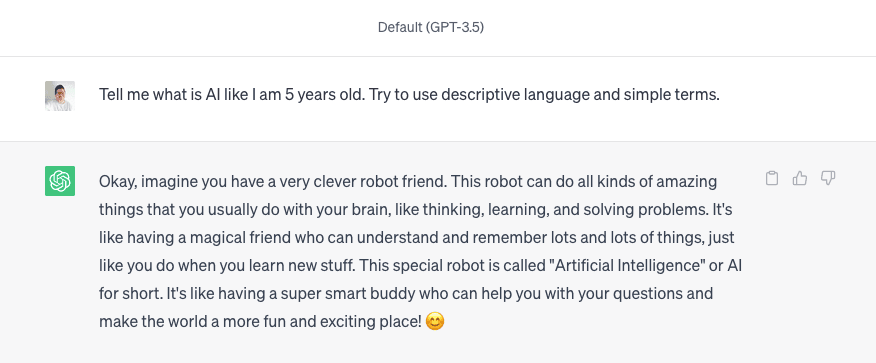
ChatGPT-4 model has much more to say on the topic of AI:
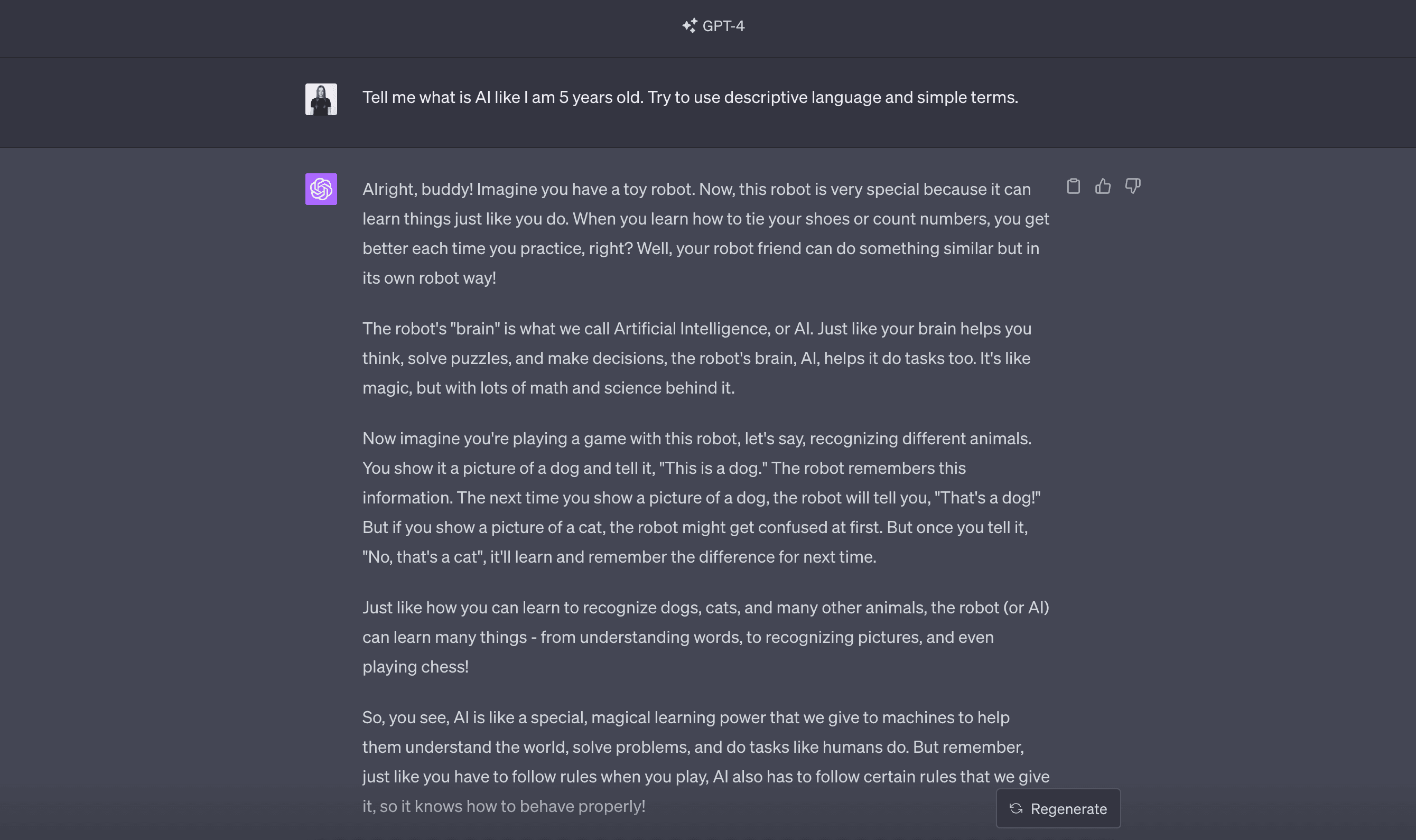
Google Bard's response concentrated on providing real-life examples of Artificial Intelligence:
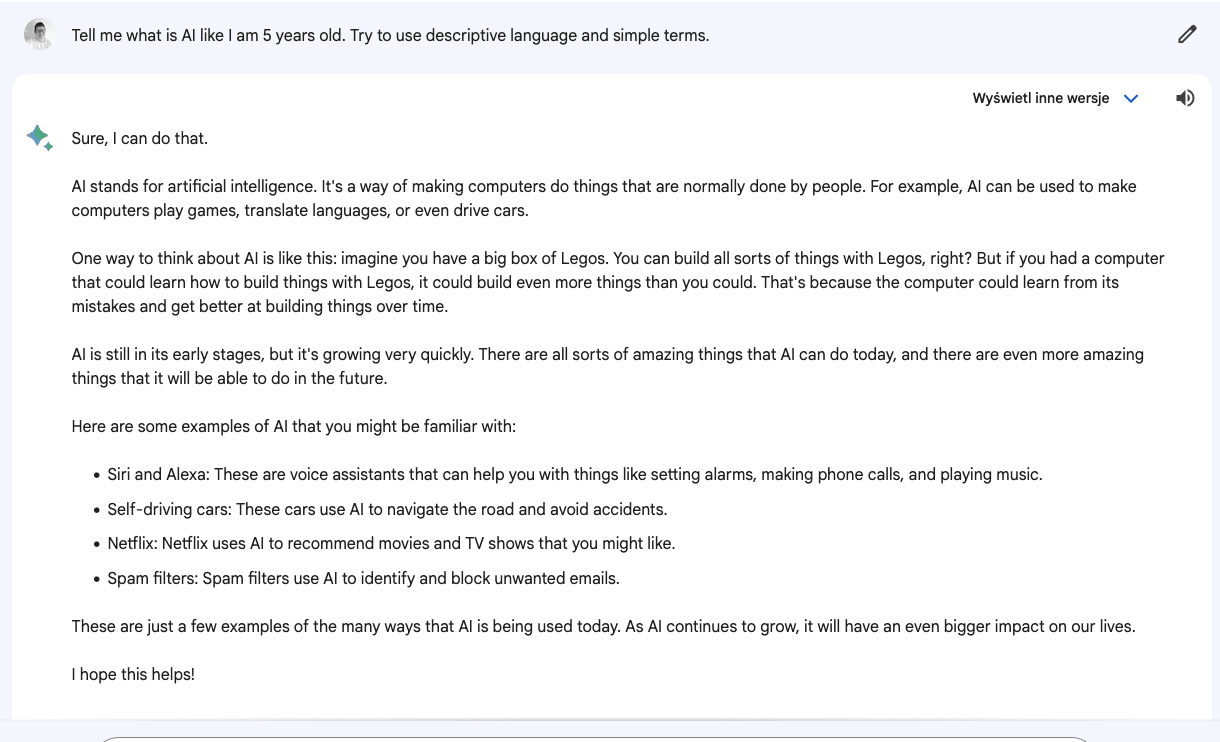
Last, but not least, we asked Microsoft's Bing Chat for its input on the AI. We chose a “creative” style of answer:
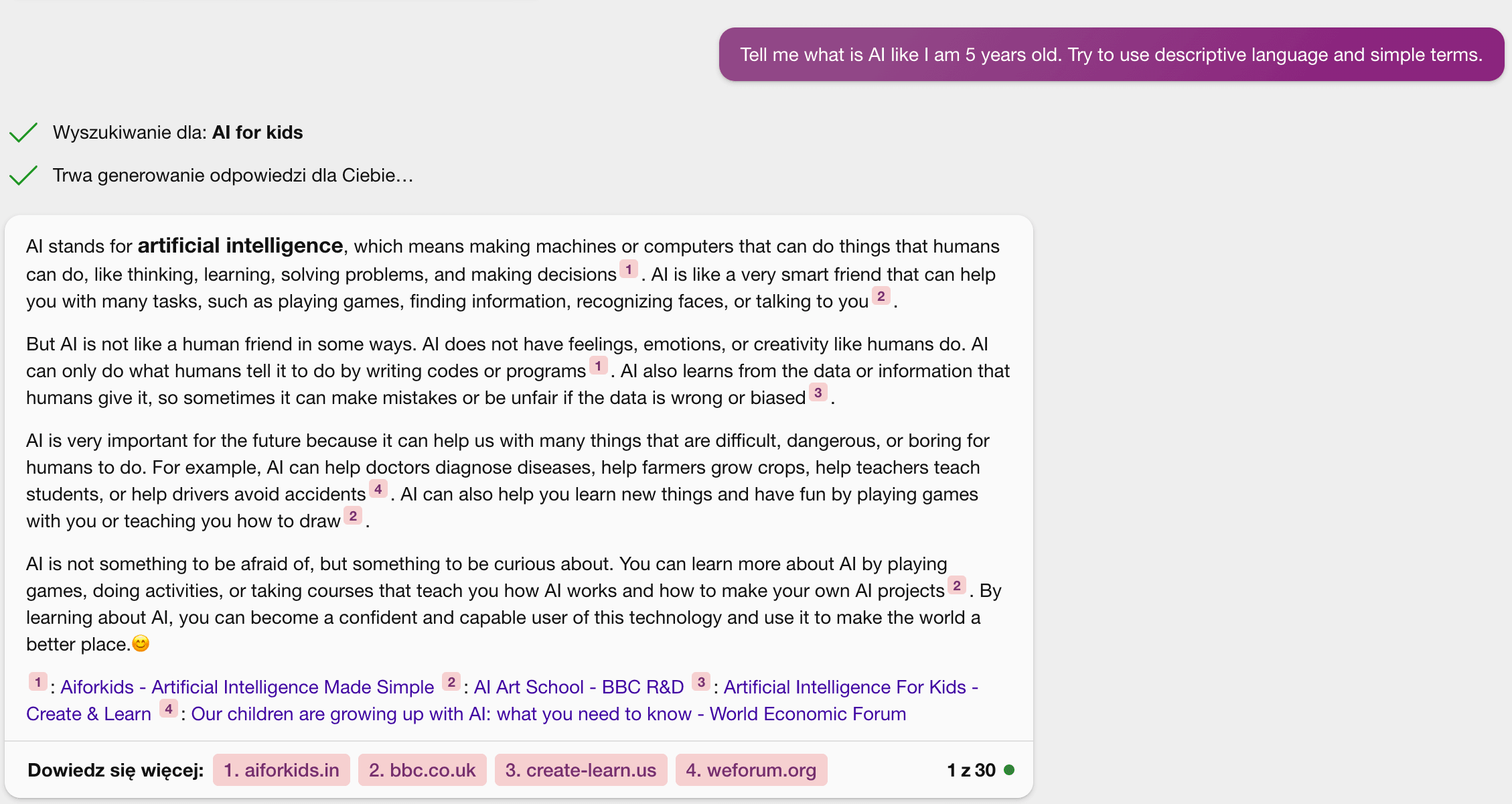
As you can see, each of the AI systems generated a different response, sometimes even mimicking human intelligence problem-solving skills. For example, Bing Chat created an answer that could easily be a part of an essay on the topic of AI for children.
The History of AI – How It All Started
The understanding of modern AI in 2023 and in the first half of the 20th century differs very much. It's quite hard to grasp the idea of a world without the technology that we own today. The computers that were operated by Alan Turing were, for example, unable to store any kind of commands. Besides that, they were only available to a small circle of scientists, as they were unimaginably expensive. Yet, Turing was the scientist to coin the term “Turing test”.
What is it exactly? Well, the Turing test is an examination of whether a machine can exhibit behaviour indistinguishable from that of human intelligence. It was introduced in 1950 in his academic paper called “Computing Machinery and Intelligence”.
How to conduct the Turing test?
The judge will speak with two test subjects, known to them as subjects X and Y, located in two different rooms. The interlocutor is not visible to the judge, and both sides should use natural language to converse. According to Turing, if the machine is not detected after 5 minutes of conversation by more than 30% of judges, then it passes the test. The algorithm called Eugene Gootsman was the first one to pass it in 2014.
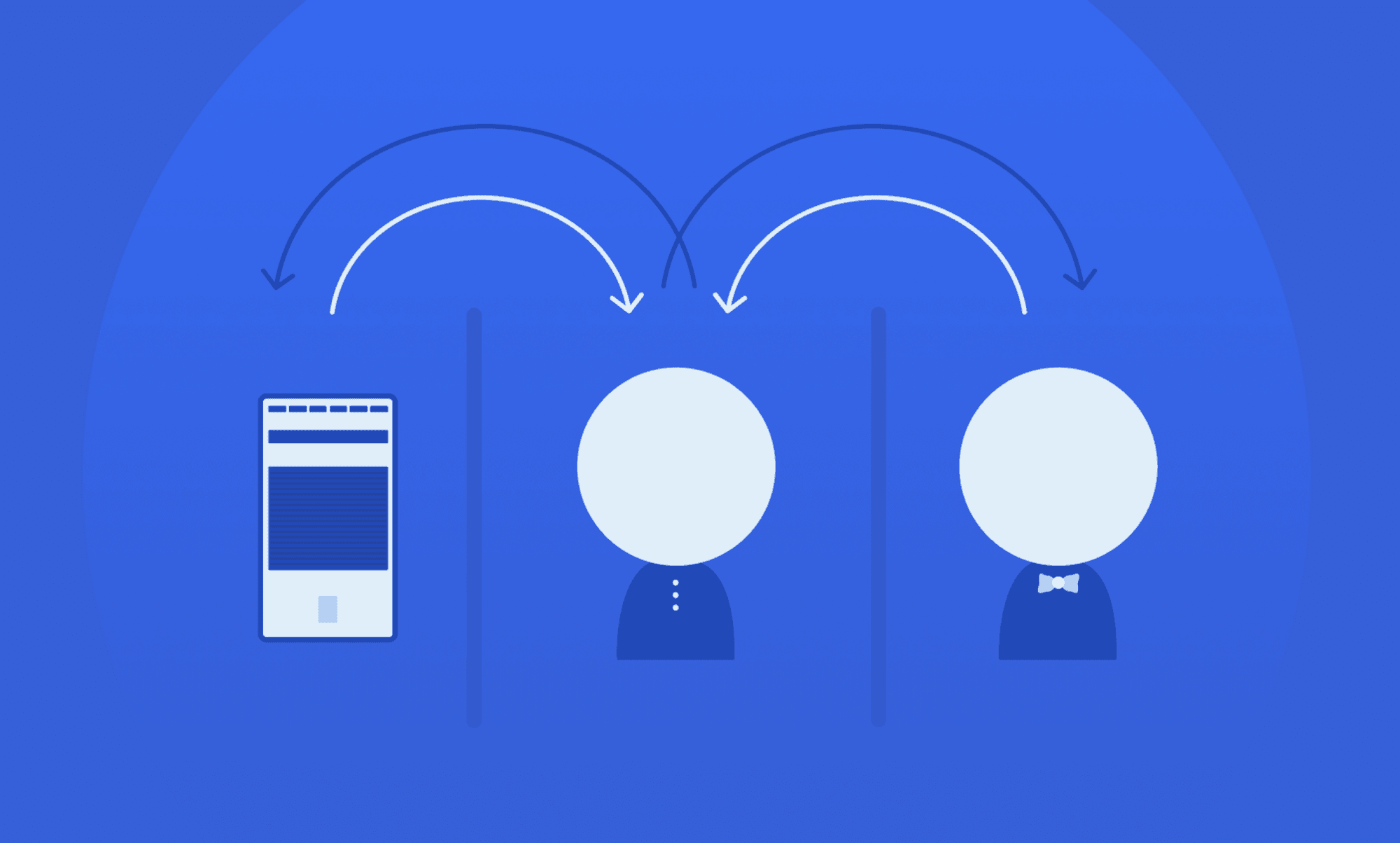
Early AI research
Early AI research could be dated to the workshop held on the campus of Dartmouth College, during the summer of 1956. Many participants went on to become leaders in Artificial Intelligence research, thus establishing the modern understanding of this science field.
The 1950s-1960s research focused on developing programs to perform tasks that required human intelligence. One notable example was the Logic Theorist, created by Allen Newell and Herbert A. Simon in 1956, which could prove mathematical theorems.
In 1957, Frank Rosenblatt developed the perceptron, an early form of neural network, capable of learning and making simple decisions. It marked the beginning of research into neural networks and machine learning.
In the 1980s, AI research shifted toward expert systems, which were rule-based systems designed to mimic the decision-making processes of human experts in specific domains.
AI Research Gains Momentum
It was only in the 1990s that the field of machine learning gained momentum, fuelled by advances in computational power and the availability of large datasets. Techniques like support vector machines and decision trees became popular.
Computer science grew exponentially in the past 70 years, with a rapid growth of processing power, lower cost of personal computers and machine learning capabilities. Since the 2000s, AI algorithms look more like our modern vision of them.
Understanding AI Using a Human Brain
Understanding AI may be tricky, but Explainable AI (XAI) is here to the rescue. What does it stand for? According to IBM, Explainable AI is a set of processes and methods that allow human users to comprehend and trust the results and output created by machine learning algorithms.
Thanks to a large amount of data and the capability to understand the context (transformer model) algorithm creates predictions of the next sentence sequence with large precision. Mostly, the output generated by modern algorithms is right and can seem like communication with a real-life human being.
Why do we need it? First, and foremost, to “translate” the language of computers to something more comprehensible to the human being. Second, to make a great algorithm be of use to humans in their daily work.
Different Types of AI
In psychology, there is a term called “Magical Thinking” which is a belief that simply thinking or wanting something can make it happen. It's this kind of behaviour that is often stopping us from understanding such complex as AI.
We see Artificial Intelligence as this kind of mythical creature (the Cthulhu of the WWW), ready to take our jobs, relations, and even our favourite hamster with it – the true villain of the story. But it's just technology.
What is Machine Learning?
Machine learning is a form of AI that uses data to train algorithms that it is based on. It enables software applications to be more accurate in predicting outcomes without them being explicitly trained to do so.
Instead of being explicitly programmed, machines use patterns in the data to make decisions and predictions. It's like a computer learning from examples to improve its performance. For example, it's how your phone's camera recognizes faces or how recommendation systems suggest movies you might like. Machine learning has become essential for many applications, from voice assistants to medical diagnosis and more.
What is Generative AI?
Generative AI, as previously mentioned, is a category of Artificial Intelligence algorithms that are designed to create new, unique content that is similar to human-generated output. The fundamental concept of generative AI is that a model is trained on a large set of examples. The model learns the patterns and relationships within the data, enabling it to create new content that is in line with the patterns it has learned. The content generated is not merely a copy or a replication of existing data; rather, it is original and often displays creativity and variation.
What Are Deep Learning Models?
Deep learning models are a class of artificial neural networks designed to learn and represent complex patterns and relationships in data. These models are “deep” because they consist of multiple layers of interconnected nodes (neurons) that transform the input data through a series of computations.
Imagine that you are trying to build software that can recognize different shapes – circles, triangles, squares, etc. Let's use an example of one of the deep learning models: Convolutional Neural Networks. To do so, CNN will look at one small patch of a picture at once. It will use filters to look for specific features in each patch, like edges or corners in each patch. These filters slide across the picture, creating a map of where these features are found. Using that information, the computer then combines these features to recognize shapes like circles and squares.
The Four Types of AI
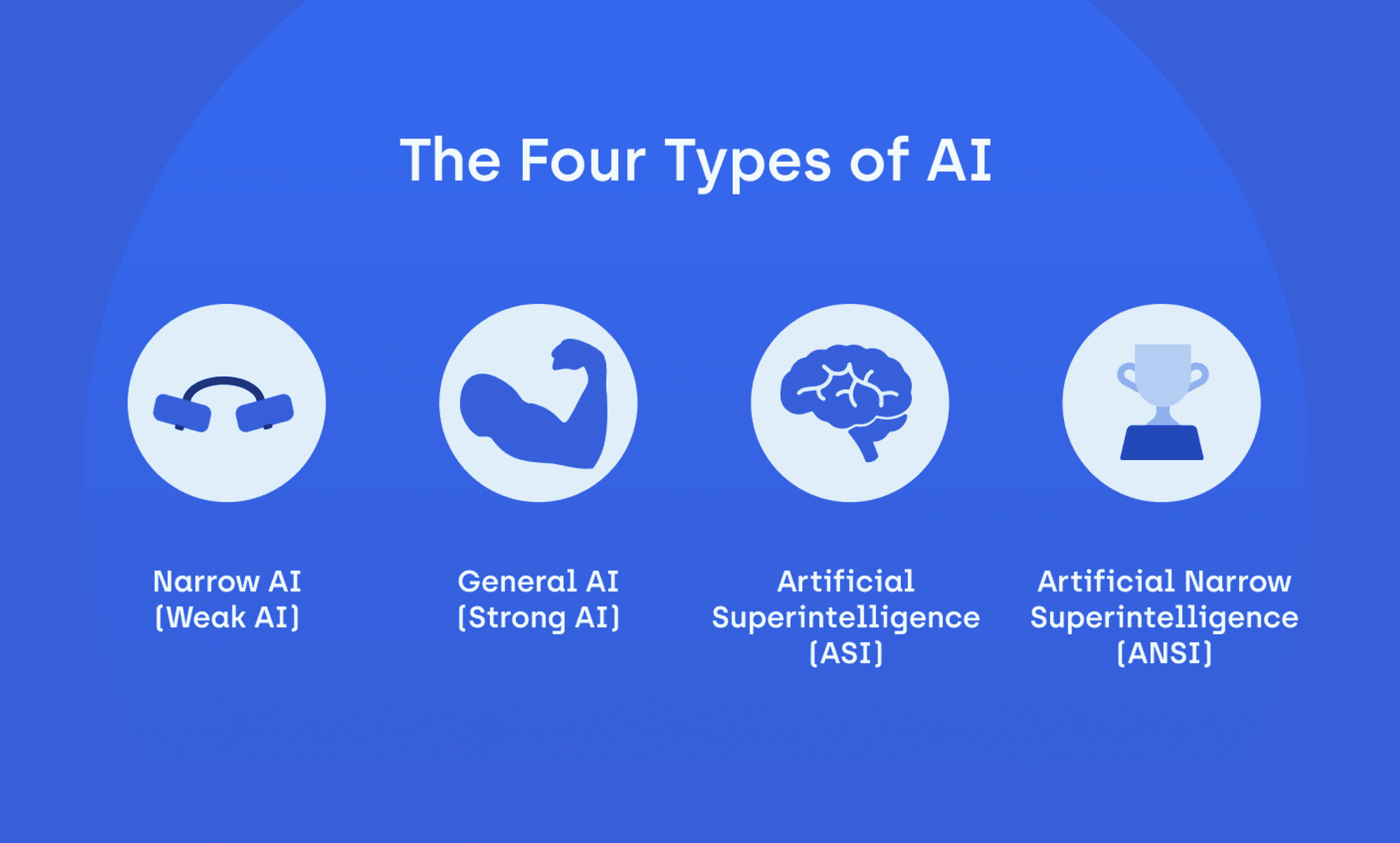
There are four primary types of Artificial Intelligence: Narrow AI (Weak AI), General AI (Strong AI), Artificial Superintelligence (ASI) and Artificial Narrow Superintelligence (ANSI). Each one of them has a unique set of characteristics that make them stand out. Let's learn more about each of the types:
Narrow AI (Weak AI)
This type of AI is designed for specific tasks and is excellent at solving particular problems. You might have seen it in virtual assistants like Siri or Alexa, which can help with everyday questions. Narrow AI is smart in its domain but doesn't understand things outside its expertise. You can also find it in image recognition (Google Images) and recommendation systems (Netflix, Spotify).
General AI (Strong AI)
General AI, also known as strong AI or AGI (Artificial General Intelligence), refers to AI systems that possess human-like intelligence and can understand, learn, and apply knowledge across a wide range of tasks. It can learn from different experiences and adapt to new situations. However, we haven't yet achieved this level of AI, and it's a big challenge to create something as versatile as the human mind.
Artificial Superintelligence (ASI)
This is a theoretical level of AI that goes way beyond human intelligence. It's like a super-smart version of AI, outperforming even the brightest human minds in almost everything, from scientific discoveries to creative thinking. Currently, it's only a concept, and some people worry about its potential risks and impact.
Artificial Narrow Superintelligence (ANSI)
This is a more advanced version of narrow AI. While it's not as smart as humans in general, it can be incredibly intelligent in specific areas. It's like a super-smart expert in a particular field, but it won't have the same wide knowledge and skills as a human. AI programs like Deep Blue (chess) and AlphaGo (Go) are examples of ANSI, excelling at their respective games but not possessing general human-like intelligence.
What are the Examples of AI Technology, and How is it Used Today?
Artificial intelligence can be found in AI tools, computer systems – and most importantly in everyday life. It can solve problems that would require human intelligence just a few years ago – making our lives easier. Here are a few more notable examples of Artificial Intelligence use:
Self-driving Cars Software
It used to be considered a wild sci-fi dream, but we do know that self-driving cars exist and are available for use by customers. They are powered by AI software that is capable of making important decisions, just like human drivers. Some notable examples include Tesla Autopilot and Full Self-Driving capability features, driverless taxis in California or the Waymo autonomous cars.
If you want to experience this wonder for yourself, try visiting California or San Francisco and ordering a driverless taxi for yourself!
Virtual Assistants
You may not be aware of that, but we carry them with us every day. How is it possible? Well, every modern smartphone is equipped with either Siri (Apple) or Google Assistant (Android). Some even decide to install a special speaker in their household – to learn about the weather, command it to play favourite music, or order groceries.
The virtual assistant created by Amazon, Alexa, is among one of the most popular solutions of this kind. AI models like this possess great capabilities in speech recognition and executing specific tasks. (Although not in all languages, non-English speakers can argue about the quality of the output they get.) They can also perform tasks commonly carried out by humans.
Speech Recognition and Synthesizing
Each human language is complicated, and that is a fact – learning one of many requires significant effort, and many have dedicated their whole lives to studying communication and linguistics. It's a good thing, that we live in a century of inventions that help us communicate daily.
Speech recognition is used by the previously mentioned virtual assistants. But it can also be used to control different machines, create realistic-sounding human voices and power various AI tools. All of that is thanks to machine learning models and natural language processing.
AI researchers created an impressive project aiming at preserving the world's language diversity using AI. Massively Multilingual Speech AI research models created by Meta can identify more than 4,000 spoken languages.
Smart Machines Software
Logistics is one of the most important fields of work in the modern, globalised world. But what about making the work of millions easier each day? That was the question that Volvo asked itself while making driverless trucks, aimed to work at global distribution centres.
Volvo Autonomous Solutions created a prototype of an AI system for the truck, that can be operated without human intervention using the Aurora driver system. It could be used potentially for long-haul drives on highways, providing help to logistics centres.
AI in Medical Field
The AI is revolutionizing the field of medicine today. For example, one of the start-ups – Infermedica – came up with the idea of introducing AI to medical assessment. It is capable of performing medical reasoning tasks and analysing patients' symptoms. One of the uses can help professionals in gaining more information about the state of the patient before their visit.
AI tools are also playing a key role in medical imaging. According to the 2019 research into AI in medical imaging, “the evaluated AI system achieved a cancer detection accuracy comparable to an average breast radiologist in this retrospective setting.” This study proves, that AI may soon help us in providing faster help to people affected by tumours.
Why is AI significant to the future?
With over 8 billion people living on Earth, the amount of new data to process is unimaginably big. AI technologies can help us with processing unlabelled data, and we can use machine learning to help humanity with meeting some of its needs in a more sustainable way.
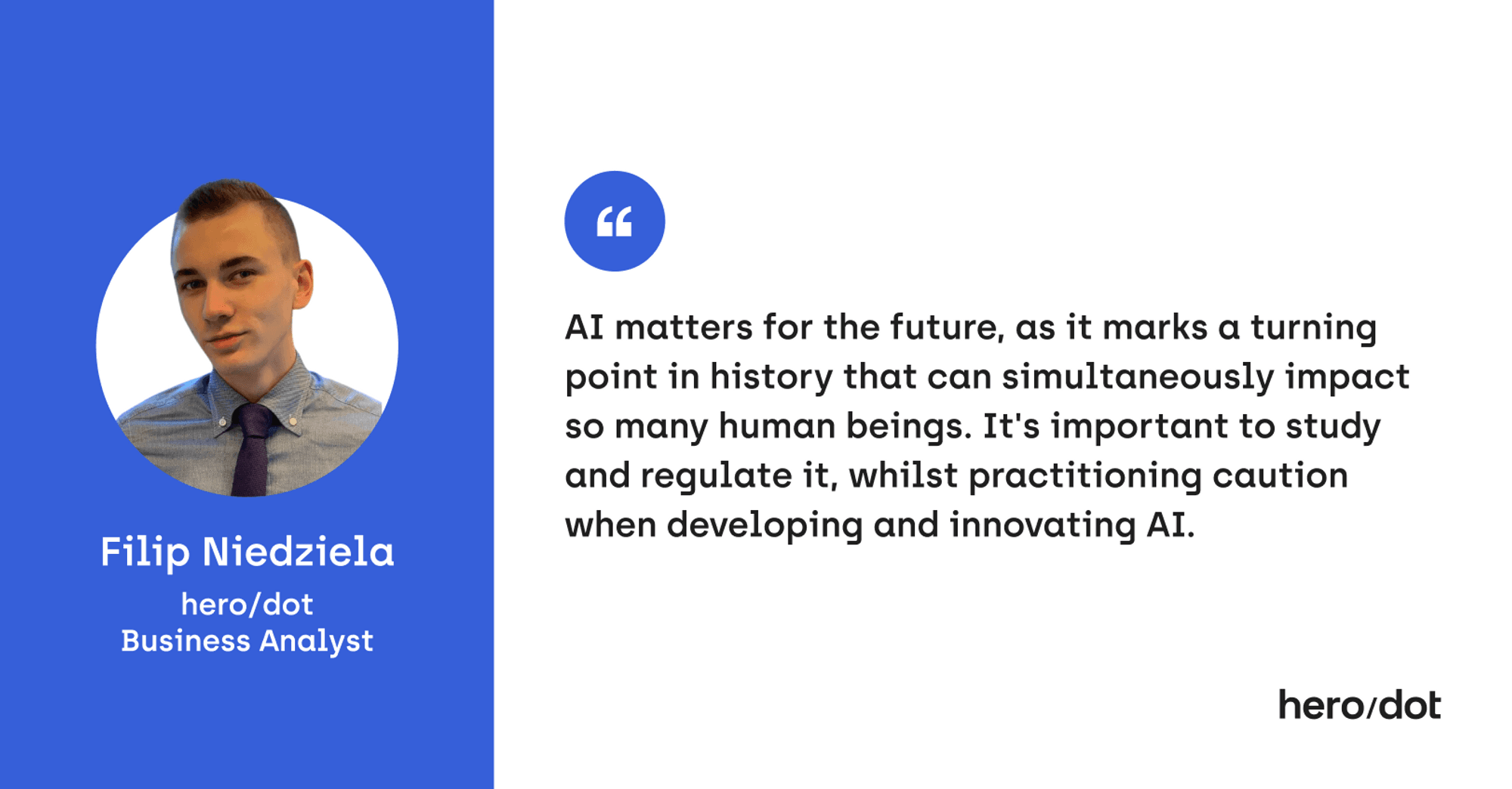
As Harvard states, AI can be used to drive insights into drug discovery and help with decision-making, such as identifying a menu of likely treatment options for patients. It can also provide basic assistance, such as lane keeping while driving or text-to-speech based on images from a phone, for the visually impaired.
Artificial Intelligence can also process enormous quantities of data, helping us learn more about the patterns that we present as a society – and keep discovering our nature. This ability can surpass what a human being could possibly discover in data sets – as it sees very complex relationships and patterns.
Besides that, we are yet to see the wonders of this technology – the current industrial revolution, driven by AI and machine deep learning techniques, will change our ideas about work, research and daily activities.
The Ethical Concerns of Using Artificial Intelligence
Each day, more people voice their concerns regarding the rapid evolution of AI. Many say it's time to regulate AI in a more strict manner. Unsupervised learning has already caused a ruckus, creating such occurrences as made-up Guardian article or acting as a way to create propaganda and fake news.
Some occupational groups also fear for their work in the age of AI. Recently, major film studios decided to offer from 35 to 200 dollars to the actors usually cast as extras, for a right to scan their likeness and use it in films as AI-generated content.
The creative industry is also worried about their workplaces, as AI-generated copywriting, movies, and drawings can be generated using tools based on generative AI, such as Midjourney, DALL-E, Adobe Firefly or ChatGPT.
The trained AI systems can also present biases, skewing the output to prefer certain data sets. As we are training Artificial Intelligence using real-life data, we also get models to learn about prejudice presented towards certain groups in society.
To tackle these issues, some companies have decided to hire an AI ethicist. They are guiding AI development with ethical considerations, as well as, ensuring compliance with regulations and standards. They are often a part of a company to make sure, that the AI tools are used with non-malicious intent in mind.
Summary
Artificial Intelligence presents both significant advancements and dangers to society. We are yet to learn more about what the future of AI will bring to the table – but definitely, it will be a great moment to reflect on the role of technology in our everyday lives.
Different Artificial Intelligence models and algorithms will soon become a part of every tool and software that we use. Everyday work is already changing due to the fact, that we can generate text, images, sound, schedules, and ideas thanks to machine learning and AI.
Remember that we are in the early days of Artificial Intelligence and while using its capabilities, it is best to proceed with caution. There is a good reason why big companies like Apple restrict their employees from using certain forms of AI. As you can see, human intervention is still needed to restrain AI usage.
We would also like to invite you to read our future publications in the article series concentrated on AI, its true colours and how it is used in everyday work by our heroes at hero/dot software agency!
If you are eager to learn more about the technology, you may also like these blog posts:
Managing Risks in Software Development Projects – A Guide to Risk Analysis by Filip Niedziela
Hyperledger In The Financial Services Industry – Overview Of The Trends by Mikołaj Zakrzowski
Android Screen Resolutions – Why Size Doesn’t Matter? by Jerzy Puchalski
Need expert assistance with your digital project?

